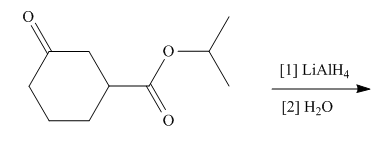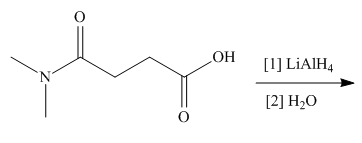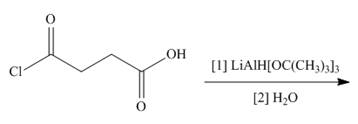
Package: Loose Leaf for Organic Chemistry with Biological Topics with Connect Access Card
5th Edition
ISBN: 9781260170405
Author: SMITH
Publisher: MCG
expand_more
expand_more
format_list_bulleted
Concept explainers
Textbook Question
Chapter 20, Problem 20.42P
Draw the products or each reduction reaction.
a. 
b. 
c. 
d. 
Expert Solution & Answer
Trending nowThis is a popular solution!

Students have asked these similar questions
If the normal potential for the Fe(III)/Fe(II) pair in acid at zero pH is 524 mV Hg/Hg2Cl2 . The potential of the saturated calomel reference electrode is +246 mV versus the NHE. Calculate E0 vs NHE.
Given the galvanic cell whose scheme is: (-) Zn/Zn2+ ⋮⋮ Ag+/Ag (+). If we know the normal potentials E°(Zn2+/Zn) = -0.76V and E°(Ag+/Ag) = 0.799 V. Indicate the electrodes that are the anode and the cathode and calculate the E0battery.
Indicate the functions that salt bridges have in batteries.
Chapter 20 Solutions
Package: Loose Leaf for Organic Chemistry with Biological Topics with Connect Access Card
Ch. 20 - Prob. 20.1PCh. 20 - Which carbonyl groups in the anticancer drug taxol...Ch. 20 - Prob. 20.3PCh. 20 - Problem 20.4 What alcohol is formed when each...Ch. 20 - Problem 20.5 What aldehyde or ketone is needed to...Ch. 20 - Prob. 20.6PCh. 20 - Problem 20.7 Draw the products formed when is...Ch. 20 - Problem 20.8 Draw the products formed (including...Ch. 20 - Prob. 20.9PCh. 20 - Problem 20.10 Draw a stepwise mechanism for the...
Ch. 20 - Prob. 20.11PCh. 20 - Problem 20.12 Draw the products formed from ...Ch. 20 - Prob. 20.13PCh. 20 - Prob. 20.14PCh. 20 - Prob. 20.15PCh. 20 - Problem-20.16 Review the oxidation reactions using...Ch. 20 - Problem-20.17 Write the step(s) needed to convert ...Ch. 20 - Problem-20.18 Oct-1-yne reacts rapidly with ,...Ch. 20 - Prob. 20.19PCh. 20 - Prob. 20.20PCh. 20 - Problem 20.21 Draw the product of each reaction.
...Ch. 20 - Problem 20.22 Draw the products (including...Ch. 20 - Problem 20.23 What Grignard reagent and carbonyl...Ch. 20 - Problem 20.24 Linalool (the Chapter 9 opening...Ch. 20 - Problem 20.25 What Grignard reagent and carbonyl...Ch. 20 - Prob. 20.26PCh. 20 - Draw the products formed when each compound is...Ch. 20 - Problem 20.28 What ester and Grignard reagent are...Ch. 20 - Prob. 20.29PCh. 20 - Problem 20.30 What reagent is needed to convert ...Ch. 20 - Prob. 20.31PCh. 20 - What carboxylic acid formed from each alkyl halide...Ch. 20 - Prob. 20.33PCh. 20 - Problem 20.34 Draw the product when each compound...Ch. 20 - Problem 20.35 Synthesize each compound from...Ch. 20 - Prob. 20.36PCh. 20 - 20.37 Devise a synthesis of each alcohol from...Ch. 20 - 20.38 Draw the products formed when pentanal is...Ch. 20 - 20.39 Draw the product formed when is treated...Ch. 20 - The stereochemistry of the products of reduction...Ch. 20 - Prob. 20.41PCh. 20 - 20.42 Draw the products or each reduction...Ch. 20 - Prob. 20.43PCh. 20 - 20.44 Draw all stereoisomers formed in each...Ch. 20 - Prob. 20.45PCh. 20 - 20.46 Treatment of ketone A with ethynylithium...Ch. 20 - 20.47 Explain why metal hydride reduction gives an...Ch. 20 - Prob. 20.48PCh. 20 - 20.49 Identify the lettered compounds in the...Ch. 20 - Prob. 20.50PCh. 20 - 20.51 Draw a stepwise mechanism for the following...Ch. 20 - 20.52 Draw a stepwise mechanism for the following...Ch. 20 - Prob. 20.53PCh. 20 - 20.54 Draw a stepwise mechanism for the following...Ch. 20 - Prob. 20.55PCh. 20 - Prob. 20.56PCh. 20 - 20.57 What ester and Grignard reagent are needed...Ch. 20 - 20.58 What organolithium reagent and carbonyl...Ch. 20 - 20.59 What epoxide and organometallic reagent are...Ch. 20 - Prob. 20.60PCh. 20 - 20.61 Propose two different methods to synthesize...Ch. 20 - 20.62 Synthesize each compound from cyclohexanol...Ch. 20 - 20.63 Convert propan-2-ol into each compound....Ch. 20 - 20.64 Convert benzene into each compound. You may...Ch. 20 - 20.65 Design a synthesis of each compound from...Ch. 20 - 20.66 Synthesize each compound from the given...Ch. 20 - Prob. 20.67PCh. 20 - Prob. 20.68PCh. 20 - 20.69 An unknown compound A (molecular formula )...Ch. 20 - 20.70 Treatment of compound C (molecular formula )...Ch. 20 - 20.71 Treatment of compound E (molecular formula )...Ch. 20 - 20.72 Reaction of butanenitrile () with methyl...Ch. 20 - 20.73 Treatment of isobutene with forms a...Ch. 20 - 20.74 Draw a stepwise mechanism for the following...Ch. 20 - Prob. 20.75PCh. 20 - 20.76 Lithium tri-sec-butylborohydride, also known...Ch. 20 - Prob. 20.77PCh. 20 - Prob. 20.78PCh. 20 - Prob. 20.79PCh. 20 - 20.80 Draw a stepwise mechanism for the following...Ch. 20 - Prob. 20.81P
Knowledge Booster
Learn more about
Need a deep-dive on the concept behind this application? Look no further. Learn more about this topic, chemistry and related others by exploring similar questions and additional content below.Similar questions
- In the battery:Pt | H2 (g) | H+ (aq) | Fe2+ (aq) | FeIndicate the cathode and anode.arrow_forwardWrite the equations that occur when the electrode Pb (s) | PbI2 (s) | KI (ac) in a galvanic cell. a) It functions as a positive electrode b) It functions as a negative electrode c) What is the ion with respect to which this electrode is reversible?arrow_forwardState the formula to find the electromotive force of a battery as a function of the potential of the anode and the cathode.arrow_forward
- Why are normal electrode potentials also called relative electrode potentials?arrow_forwardEasily differentiate between electrochemical potential and Galvani potential.arrow_forwardConstruct a molecular orbital diagram for carbon monoxide. Identify the relevant point group,include all of the appropriate symmetry labels and pictures, and fill in the electrons. Make sure toaccount for the difference in electronegativity between C and O. Hint: CO is substantiallyisoelectronic to N2. (PLEASE DRAW THE ENTIRE MO DIAGRAM!!!)arrow_forward
arrow_back_ios
SEE MORE QUESTIONS
arrow_forward_ios
Recommended textbooks for you
 Organic ChemistryChemistryISBN:9781305580350Author:William H. Brown, Brent L. Iverson, Eric Anslyn, Christopher S. FootePublisher:Cengage Learning
Organic ChemistryChemistryISBN:9781305580350Author:William H. Brown, Brent L. Iverson, Eric Anslyn, Christopher S. FootePublisher:Cengage Learning

Organic Chemistry
Chemistry
ISBN:9781305580350
Author:William H. Brown, Brent L. Iverson, Eric Anslyn, Christopher S. Foote
Publisher:Cengage Learning
Nomenclature: Crash Course Chemistry #44; Author: CrashCourse;https://www.youtube.com/watch?v=U7wavimfNFE;License: Standard YouTube License, CC-BY